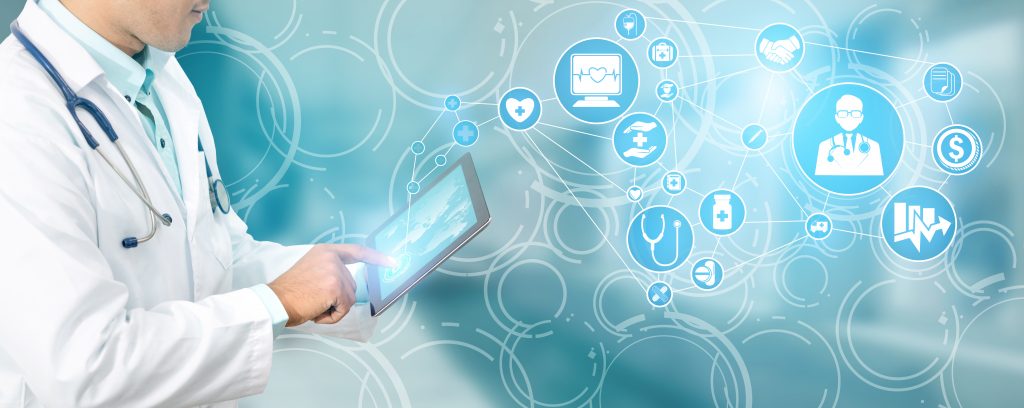Previously, we wrote about COVID-19 making telemedicine a new normal and that it has a strong potential to remain in high usage beyond the pandemic. Telemedicine was once a niche model of health care delivery but has become more mainstream as an answer to providing healthcare during the COVID-19 crisis. Even with re-opening and the return to non-critical doctor visits, telemedicine remains prevalent and in use at a level significantly higher than pre-COVID.
While telemedicine increased significantly because of COVID, the practice was quickly on the rise prior to the pandemic. It was making its way into the mainstream, and the future of telemedicine looks bright. Compared to 2019, patient adoption of telemedicine use rose by 33% in 2020, and funding has also been trending upward, with the market estimated to grow to $185.6 billion by the year 2026.
Over the past few years, patients have shown an increased comfort level with using technology for health services, and online resources have overtaken word-of-mouth referrals. More patients also prefer online booking and digital communication over traditional phone calls. Even as more doctors are accepting in-person appointments, patients are continuing the trend of seeking virtual solutions through telemedicine. This shows us that telemedicine is here to stay.
The Challenges of Telemedicine Adoption
The surge in telemedicine has stressed the unprepared system, practices and highlighted deficiencies and aspects that need improved reliability. This not only poses huge opportunities for vendors and patients alike, but it also presents us with significant challenges. One such challenge includes researchers’ predictions that telemedicine will be able to provide better patient outcomes with the use of more remote diagnostic equipment and user-friendly sensors. They also see more opportunities for care through the practical application of AI robotics, with advancements like interactive virtual assistants.
Providers need to make substantial investments in hardware, software, and the training of personnel in how to use telemedicine. More hospitals are beginning to develop in-house software that nicely integrates with their existing electronic medical records system. However, this software development and implementation can take time to ensure it works properly and is secure to east privacy concerns.
Another area of deficiency for the effective implementation of telehealth is the lack of medical devices in the home. Every office, emergency room, and hospital visit starts with the standard patient vital measurements. Although there may be a few reasons for this, the most important is that the results are indicators of potential medical problems for the patient. The lack of medical devices in the home limits the effectiveness of telemedicine doctor’s visits, monitoring, and treatment.
Valid Telemedicine Concerns
Telemedicine devices will need several technologies to support the growing practice. Each medical device, possibly as simple as a thermometer or weight scale, will need wireless connectivity. The device will need to transmit information to the medical provider to be recorded into the patient file. The transition, likely through the patient in-home hub, will need to support end-to-end encryption for privacy and meet HIPPA compliance. The device will need an internal function to support encoding and decoding the encryption. One less considered function of biometric or diagnostic measurements is that health care providers and insurance companies want trained professionals to take and record these measurements to ensure accuracy, correctly read and interpreted data from properly applied medical devices. Someday there may be requirements to detect the “real” patient is being monitored through means like biometric identification.
An example of telemedicine concerns relative to basic patient measurements comes from the Centers for Medicare & Medicaid Services (CMS). Throughout the COVID health emergency, the CMS made compromises and allowed patients to self-report via telehealth their vital signs and other biometric data during Medicare annual wellness visits (AWV). There has been some concern about obtaining accurate needed biometric data (e.g., weight, height, blood pressure, etc.) after CMS enabled telehealth to be administered to patients at home during the COVID emergency. The medical devices described prior will alleviate the concerns.
These dynamics are leading to the telemedicine medical device market that requires more capability, connectivity, security, and mobility technologies to be adapted to support the remote healthcare trends. Hence, the rush to provide more home-use biometric measurement and diagnostic medical devices is on.
The Future of Telemedicine
Companies looking to develop such devices but lacking expertise or bandwidth can turn to companies like Devicelab for product realization. Devicelab, foreseeing this demand and telemedicine trend, has invested years developing high-tech, secure remote medical device platforms based on state-of-the-art wireless connectivity, electronics, and medical device technologies. This includes software that ensures privacy and security measures that meet HIPPA regulations. Their proven platform can be leveraged to reduce time to market, enable telemedicine for patients and practitioners, capitalize on the increasing telemedicine demand, alleviate the current limitations in this practice and improve remote healthcare.
Telemedicine may have entered a tipping point during the COVID emergency, seeing a spike in its usage, and it could continue to gather the momentum needed to be sustainable once the crisis is over. This will be supported by improvements and access to personal mobile technology, the proliferation of 4G and 5G networks, a digitally-savvy population, and changing regulatory and reimbursement structures. These shortcomings are sure to be addressed in time. Devicelab can be a partner for solving telemedicine medical device and software demands.



